Blue elderberry (
Sambucus nigra ssp
caerulea) is tough, fast growing and unfussy, and is one of the best wildlife plants for a garden. Showy, fragrant spring flowers are followed by bluish fall berries. Both the flowers and the berries attract a plethora of birds and wildlife in the plant’s native California region. Blue elderberry can be a weed in some habitats. Use good judgement when selecting this plant. It is best in its native regions.
Caution: Blue elderberry flowers and berries can be consumed as food, drink and medicine when ripe and cooked but are poisonous when underripe.
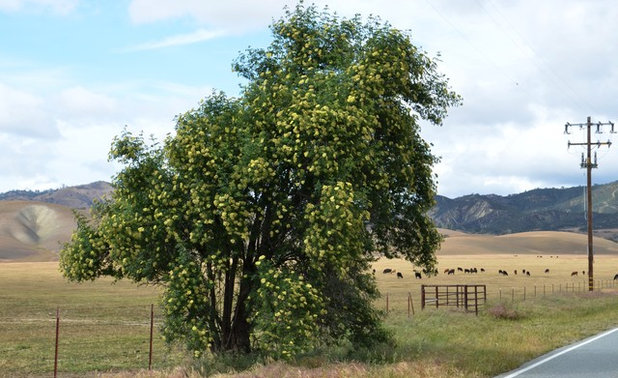
Pete Veilleux, East Bay Wilds
Botanical name: Sambucus nigra ssp
. caeruleaCommon names: Blue elderberry, Mexican elderberry
Origin: California Sierras and coast ranges north into British Columbia and south into Baja California; from the California coast east to New Mexico
Natural habitat: Canyons; valleys; cool, open places; many plant communities. Prefers moist riparian habitats; grow it below 10,000 feet.
Where it will grow: Hardy to -5 degrees Fahrenheit (USDA zones 6 to 10; find your zone)
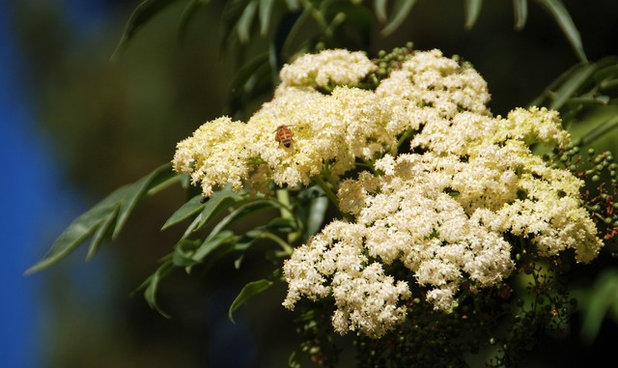
Pete Veilleux, East Bay Wilds
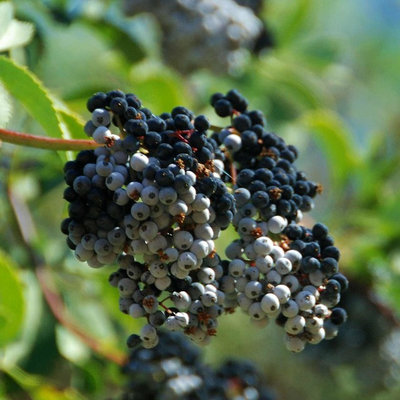
Pete Veilleux, East Bay Wilds
Water requirement: Drought tolerant to moderate water; will flourish in or next to regularly irrigated areas. (Other species of
Sambucus are not drought tolerant.)
Light requirement: Full sun to partial shade; flower and berry production is best in full sun
Soil: Adaptable; prefers well-drained soil
Mature size: Typically 8 to 15 feet tall and wide in gardens; with optimal water it can reach 20 to 25 feet tall. In areas with cold winter temperatures, it will die back and regrow to a shrub of 6 or 8 feet wide and tall.
Benefits and tolerances: Provides nectar, fruit, cover and a nesting spot for a huge number of critters: birds, native bees, honeybees, butterflies, hummingbirds, chipmunks and many others; attracts pollinators; attracts predatory and parasitic insects (the good bugs that destroy the bad bugs); good with oaks; tolerates clay; tolerates sand but not salty seaside conditions
Seasonal interest: Spring to summer flowers; fall berries
When to plant: Late fall is ideal; winter works well; spring is acceptable; summer can be challenging to all but the most experienced gardener
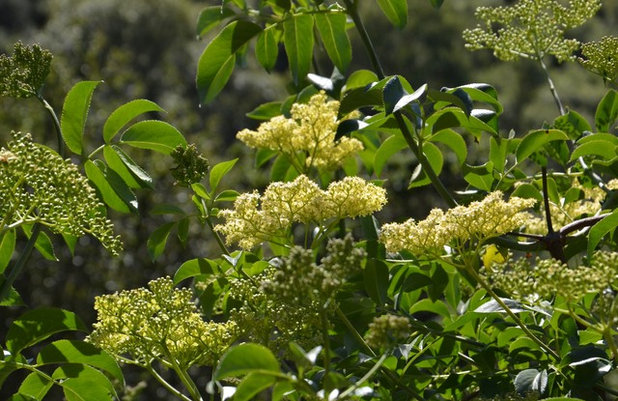
Pete Veilleux, East Bay Wilds
Distinguishing traits. Blue elderberry’s delicate lacy flower umbels veil its informal and tough nature. Displayed in a graceful weeping habit, the creamy white flowers have a delightful fragrance — like spiced honey — that floats on the warm summer breeze. Bursting forth in spring and continuing through summer, the flowers are following by berries. The berries start small and green, then they take on their full purple-black ripeness in the fall. A whitish powder coating gives the dark berries a bluish cast that inspired its name, blue elderberry. Eventually claimed in the winter, blue elderberry goes deciduous.
Also drought deciduous, blue elderberry is a perfect example of how plants have evolved to California’s Mediterranean climate. As it is with blue elderberry, sometimes “drought tolerant” can mean “drought deciduous.” In nature, blue elderberry thrives in riparian habitats (next to waterways). Yet it is drought tolerant once it’s established. During a drought the flower and fruit production is reduced, and the leaves drop in the summer heat. This is how blue elderberry — and many other drought-tolerant plants — survive our long, dry California summers.
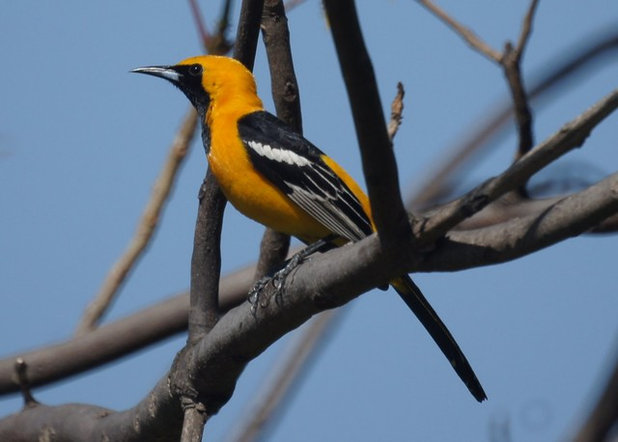 Wildlife value.
Wildlife value. No matter what article or book I read, everyone agrees that blue elderberry is one of the best shrubs for attracting wildlife, especially birds, like this hooded oriole (
Icterus cucullatus).
A dream come true for birds, blue elderberry provides important food, cover, and perching and nesting sites. There are more birds attracted to this plant than I can list, including hummingbirds, jays, thrashers, finches, warblers, orioles, bluebirds, grosbeaks, mockingbirds, sparrows, vireos, pigeons, bluebirds, magpies, western tanagers, towhees, woodpeckers, grouse and quail.
Photo by Mike’s Birds
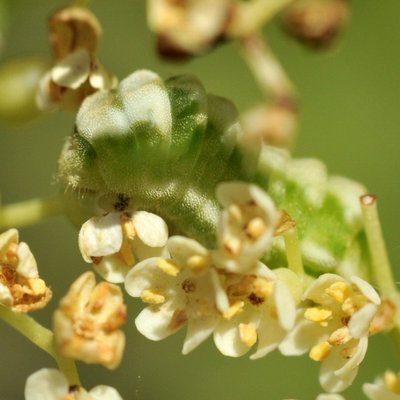
Treebeard
Blue elderberry entices many beneficial insects. The nectar is tasty to many pollinators, including native bees, honeybees and butterflies, while also attracting predatory and parasitic insects that prey on pest insects. Even the “bad” bugs, like this well-camouflaged caterpillar, could be lunch for some hungry bird!
In the California central valley, blue elderberry is protected, because it is the host plant to the federally threatened valley elderberry longhorn beetle.
With its yummy berries and good cover, many other large and small critters use blue elderberry for protection and food. You’ll often find chipmunks and other little cuties in and around it. Although particularly attractive to birds, blue elderberry makes a wonderful contribution to any wildlife garden.
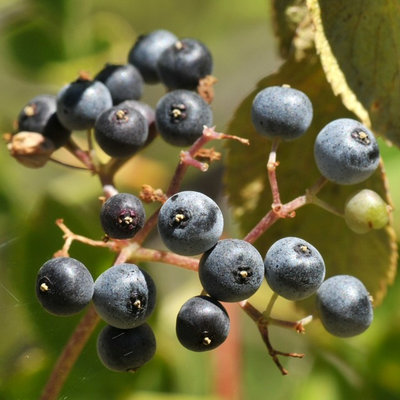
Treebeard
How to use it. Use blue elderberry for wildlife, bird, butterfly and hummingbird gardens. It can be left as a natural shrub or trained for hedges, screens or windbreaks, or as a small multitrunk tree.
Often used in habitat restoration projects, blue elderberry is highly prized for its food and cover value, productivity, adaptability, ability to stabilize slopes and fast, easy establishment.
Not only tasty to critters, blue elderberry has long been used for medicinal purposes and for foods and drinks. Although parts of blue elderberry are highly poisonous, the flower heads and the fully ripened, deseeded berries are lowest in toxins. Any toxin in the fruit and flower heads is destroyed when cooked. The cooked berries are delicious in sauces, jams and wines, as well as in the German soup
Fliederbeersuppe and many other traditional drinks and foods.
The flower heads make delicious infusions, syrups, teas, jellies, wines and can even be used in fritters. Use moderately; in large quantities the hydrocyanic acid of elderberry can have a laxative effect — so let’s eat and drink in moderation as we toast the birds for sharing their bounty with us.
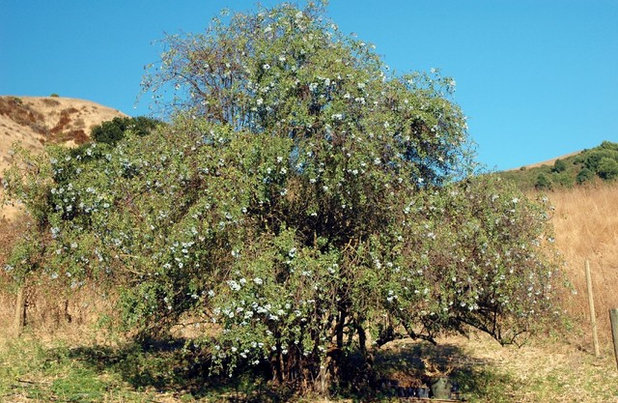
Pete Veilleux, East Bay Wilds
Planting notes. Blue elderberry is happiest when planted with plenty of space to fill out. It grows fast — it can get to 15 feet tall in three years if happy — so you won’t be waiting long.
Annual hard pruning improves its form. The elderberry shown here has never been pruned, but with a little careful pruning it could have exceptional form. If blue elderberry gets too large or too rangy, it can be renewed by cutting it to the ground during its winter dormancy.
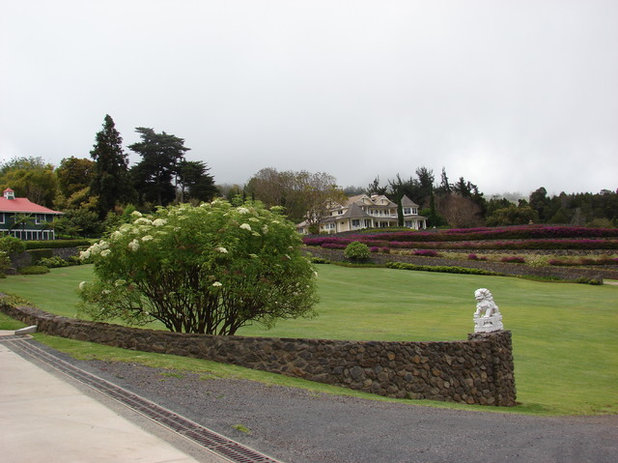
One of my favorite ways to prune a large native shrub is by skirt pruning it into a small multitrunk tree. Not only will the plant have a lovely vase shape, but it will grow taller, show off its bark and create additional space underneath it where annuals and perennials can be grown. That means a greater diversity of plants in a small garden. The young blue elderberry shown here fits into the elegant formal landscape because regular skirt pruning has created an attractive vase shape.
During drought years I give my natives a couple of deep waterings on cool and overcast spring mornings. This helps the plants through the summer. If your water district allows summer irrigation, you can provide a few summer waterings to maintain the foliage and keep the flower and berry production going.
Photo by Forest and Kim Starr, Starr Environmental
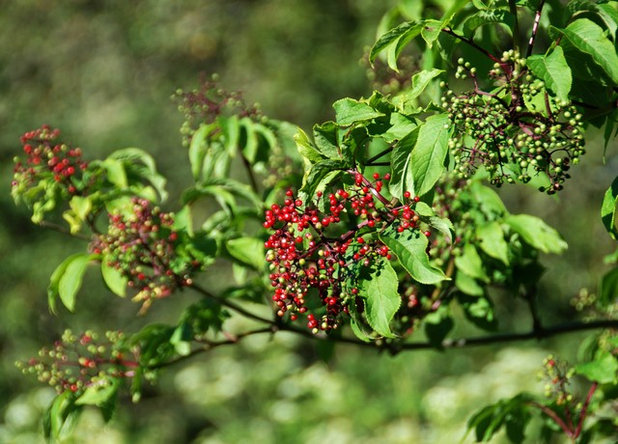
Pete Veilleux, East Bay Wilds
Other species. Red elderberry (
Sambucus racemosa) is native to many states, including California. It needs regular moisture and is not drought tolerant. Other species of
Sambucus may be more toxic than blue elderberry.
More: 8 Native Shrubs for Year-Round Bird Feeding
Browse plants native to other regions of the U.S.





